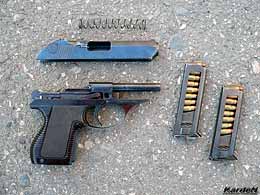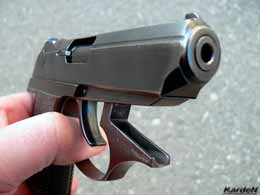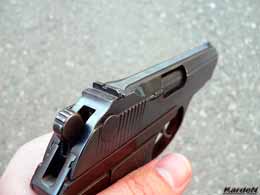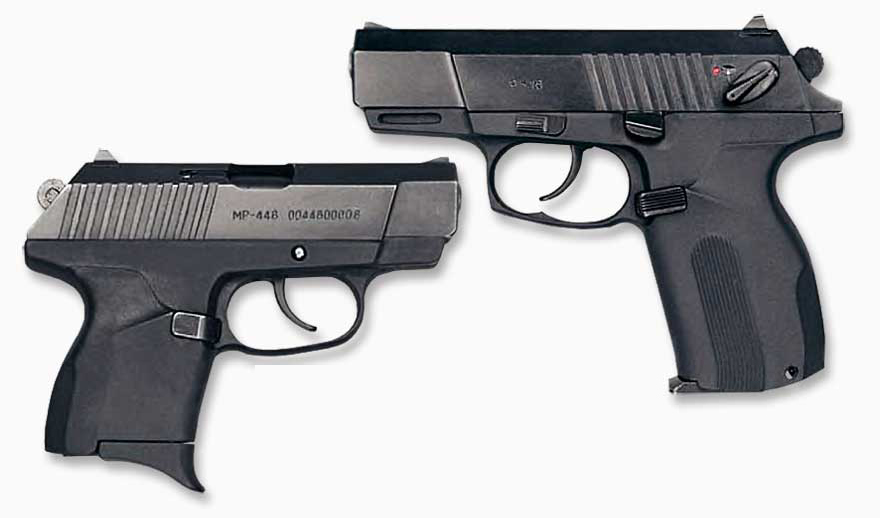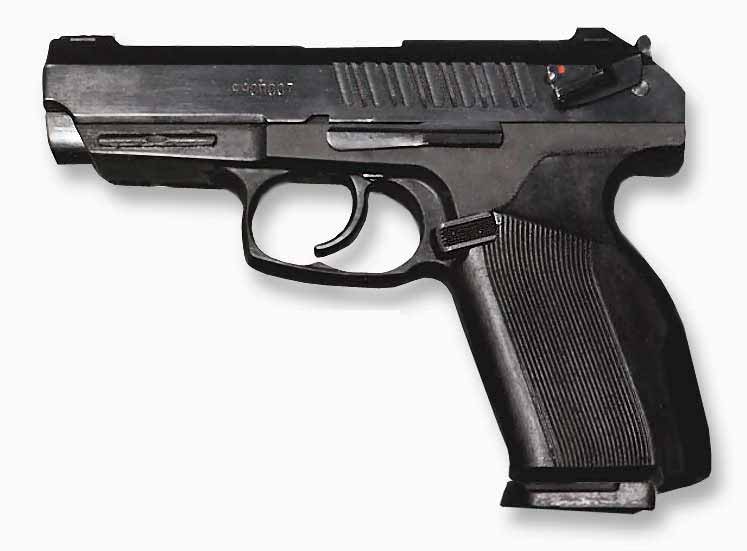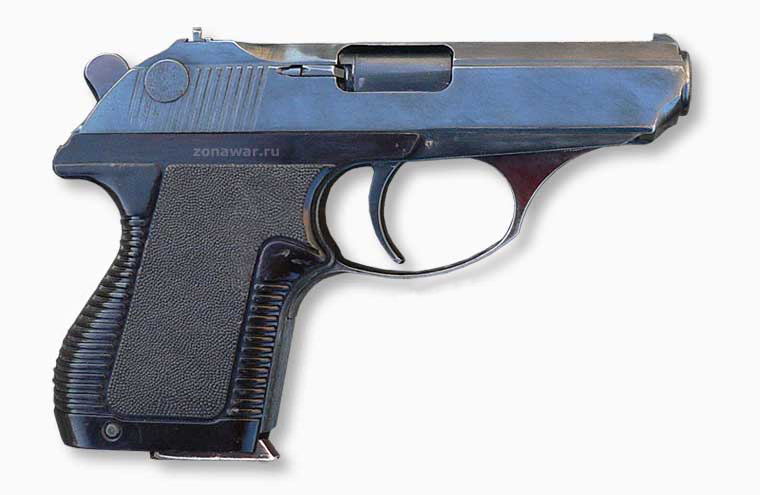 PSM small self loading pistol
PSM small self loading pistol
The task for developing a compact pistol was issued in 1970. St was necessary to develop a flat concealed carry pistol for law-enforcement personnel, with no parts protruding from the sides, weighing not more than 0.5 kg with a loaded magazine. The specification requirements also envisioned developing a new small-caliber cartridge, i. e. the pistol was to be developed from scratch. The caliber was to be 5.45 mm and the question was an all-new small-caliber cartridge. The MPTs round, developed by TsniiTochMash designers A. I. Bochin (project manager), A. D. Denisova, L. S. Nikolaeva, and G. P. Shamina, had a bottlenecked. slightly tapered cartridge case and an ogival bullet with a small flat tip. The steel-cored bullet had a weight of 2.4 g, while the lead-cored one weighs 2.8 g. Compared to the 6.35 mm Browning cartridge, the lighter 5.45 mm cartridge having similar dimensions offered 1.4- to 1.5-fold greater muzzle energy (119 joules for the steel-cored bullet and 129 joules for the lead-cored bullet as against 83-86 joules for the lead-cored Browning cartridge). This has ensured its good penetration performance. The bullet of the 5.4×18 cartridge (designated 7N7) can be stopped by class 2 or higher body armor. It has a significantly lower stopping power than the PM round due to its lower weight, which might be caused by one of the requirements of the law-enforcement agencies that the new pistol should render a human target ineffective without necessarily killing it.
The pistol was developed by a team of designers of the Tula-based Sporting and Hunting Guns Central Research and Design Bureau (TsKlB SOO), comprising T. I. lashnev, A. A. Simarin, and L. L. Kulikov. The 5.45 mm pistol passed the official tests from first submittal and entered the inventory under the designation of PSM, which stands for Pistolet Samozaryadny Malogabaritny (pistol, self-loading, small ), and the index of 6P23 in December 1972. in 1976 the PSM pistol was put into production at the Izhevsk Mechanical Plant. The PSM pistol was originally designed for police and internal-security forces, but also entered service with the lop brass of the Armed Forces, security services, the slate guard service, special-purpose drivers, etc. After several hijackings of Aeroflot airliners, including crew member kills, it was proposed to equip the airliner flight crews with PSM pistols.
The pistol is a fixed-barrel blowback-operated weapon. The recoil spring is wound around the barrel. The protruding trigger guard limits the recoil of the slide. During a field stripping the spring-loaded trigger guard is shifted downward.
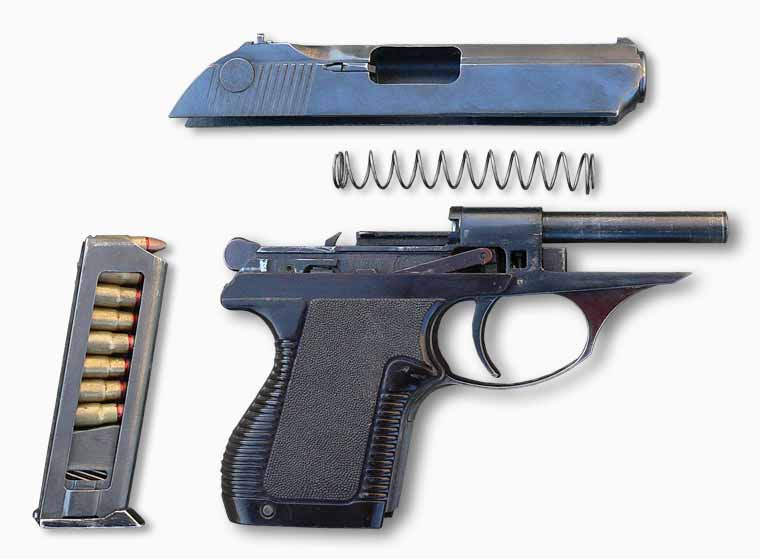 Incomplete disassembly of the PSM pistol
Incomplete disassembly of the PSM pistol
The pistol is fitted with an external-hammer trigger assembly. The cylindrical spiral hammer spring is linked to the hammer by a bar. The firing pin is mounted inside the slide. The double-action trigger assembly enables single-shot fire by either cocking the pistol in advance or by self-cocking. The half-cock option allows the pistol to be carried ready for action with the safety catch off without a risk of an unintended shot, if the pistol is dropped or shaken violently. The sear has a tooth engaging She safety catch, and a notch for engaging the trigger bar. The manual safety levers mounted on the slide, blocks the sear, the slide, and the trigger in the forward position, while simultaneously releasing the hammer from the sear notch and preventing it from striking the firing pin. The safely catch, fitted so as to protrude at the rear of the slide, allows the shooter to rotate it to the lire position and cock the hammer by a single move of the thumb of the firing hand or the palm of the other hand.
When the trigger is pulled in the single-action mode, the trigger bar moves forward, lifts, and rotates the sear with its tooth, slipping it out of the notch in the hammer. The-hammer is then free to go forward forced by the hammer spring and drive the firing pin forward to fire the cap. The recoiling slide forces the trigger bar downward, clear of the sear tooth, the hammer rotates and forces the hammer strut downward, compressing the hammer spring. The sear is then pressed against the hammer by its spring. As the hammer is rocked back by the slide, the sear engages and holds the hammer notch. In the double-action mode, the hammer is cocked and released by pulling the trigger. When this occurs, the cocking Sever moves forward and engages the hammer self-cocking tooth, the hammer then rotates and forces the cocking Sever out; the cocking lever engages the sear and moves it out of engagement with the hammer, which swings forward under the action of its own spring, to drive the firing pin into the cap.
The spent cartridge case is ejected from the chamber by the cartridge extractor, mounted inside the slide, and the cartridge ejector.
The pistol is fed from a single-column eight-cartridge magazine, inserted into the pistol grip. The magazine features large side windows, with the feeding device moving inside. The protruding parts of the feeding device feature notches to make magazine loading easier. The rear end of the protruding trigger guard rests against the front wall of the magazine, thus, it is impossible to deflect the trigger guard and strip the pistol without ejecting the magazine first, which improves the pistol handling safety. When the magazine is empty, the slide remains to the rear.
The slide also carries a foresight and a fixed sight.
The pistol can easily be handled with one hand. The metal pistol-grip stock attached to the frame by a lock pin instead of a screw is another unique feature of the PSM pistol. Replacement of a screw joint, which requires special tools for assembly and disassembly, with a lock pin has made assembly and disassembly of the pistol easier and ensured reliability of the pistol grip attachment. The ‘wrap-around’ grip protects the side windows and the rear part of the frame, and prevents the pins from failing out in the course of operation.
The pistol is small and flat, with no parts protruding to the sides, which makes concealed carry and quick pulling-out easier. Its relatively Song barrel — 85 mm (15.5 calibers) — and a powerful cartridge for such a small caliber have resulted in good ballistics at practical pistol ranges.
A whole range of belt, inside-the-pants, and ankle holsters have been developed for the using the PSM pistol as an extra gun.
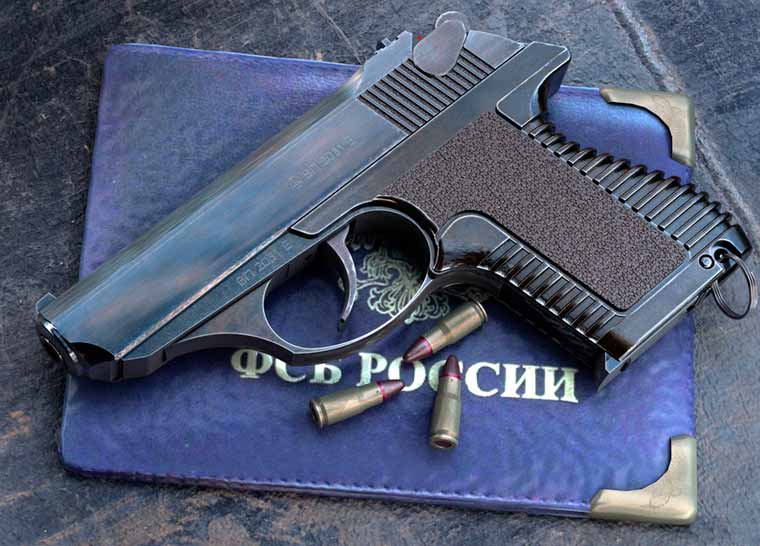 PSM small self loading pistol
PSM small self loading pistol
However, the ‘flatness’ of the pistol has affected its handling performance — the small pistol grip did not ensure the sufficient tightness of the clasp of the palm. The palm does not have full contact with the pistol grip, while the trigger is pulled by the middle phalanx of the index finger. Thus, the flat aluminum-alloy pistol grip was replaced with a longer and wider plastic “wrap-around5 ribbed pistol grip, which makes pistol handling considerably more comfortable. Ii increases the pistol’s stability during and after shot, thus improving the accuracy. The new pistol grip increased the overall pistol width by 2 mm.
In the 1990s, the Izhevsk Mechanical Plant offered an export version of the pistol designated IZh-75, which almost did not differ from the baseline model, and later the MP-441 (Baikai-441) model — a PSM version chambered for the 6.35 mm (0.25 ACP) Browning ammunition popular abroad. The pistol became markedly wider and was fitted with an indicator of a round in the chamber. An adjustable rear sight was a curious feature of this “pocket” pistol.
Gas pistol variants are also available. The 6P37 pistol developed by V. A. Yarygin, became the first one St was designed to fire the domestic 7.62 mm gas cartridge. The original gas pistol was a smooth-bore weapon, later it was fitted with a bore-mounted separating spring. Later on designers developed a variant, which fired 8 mm cartridges. IZh-78 and IZh-78-8 (firing the 8 mm gas cartridge) gas pistols have been in production since 1996-1997. They featured ‘weakened’ bore walls made of worse steel — it would be more difficult to adapt such a pistol for firing service cartridges.
The lZh-78-9T, a non-lethal derivative of the lZh-78 pistol chambered for the 9 mm RA rubber-bullet or gas cartridges, appeared on the market in 2004.
Specifications PSM pistol
Caliber: 5.45 mm
Cartridge: 5.45×18 MPTs
Weight w/o cartridges: 0.46 kg
Length: 155 m
Length of barrel: 85 mm
Bullet muzzle velocity: 315 m/sec
Effective rate of fire: 30 rds/min
Sighting range: 50 m
Magazine capacity: 8 rds
Photo review pistol PSM

